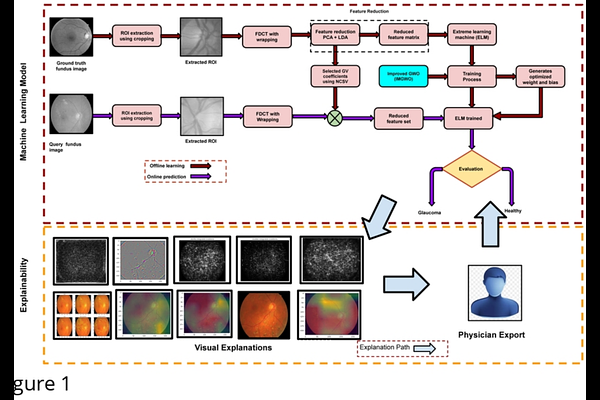Explainable AI-Driven Diagnosis Model for Early Glaucoma Detection Using Grey-Wolf Optimized Extreme Learning Machine Approach

Explainable AI-Driven Diagnosis Model for Early Glaucoma Detection Using Grey-Wolf Optimized Extreme Learning Machine Approach
Muduli, D.; Sharma, S. K.; Dash, S.; Lemos, B.; Mallik, S.
AbstractGlaucoma is a prominent threat to vision and ranks as the third leading cause of blindness in India. Early detection is crucial to limit its progression. Retinal image analysis, particularly computer-aided diagnosis (CAD), has gained significant attention due to its potential in effectively screening for and managing glaucoma. Nowadays, Artificial intelligence (AI) has achieved significant progress has been made in medical image analysis across various applications. However, the main challenge hindering the widespread adoption of deep neural models in clinical settings is their lack of interpretability. In response to this need, we propose an enhanced CAD model with four key components: image pre-processing, feature extraction, feature dimensionality reduction, and classification. Utilizing the G1020 and ORIGA datasets, we employ a fast discrete curvelet transform with wrapping (FDCT-WRP) for curve-like feature extraction. A combined feature reduction technique, principal component analysis (PCA) and linear discriminant analysis (LDA), is applied to generate relevant features and reduce the feature dimensionality. Incorporating an improved grey wolf Optimization (IMGWO) with an Extreme Learning Machine (ELM) for classification. Then, IMGWO optimizes parameters, enhancing the efficiency of single-hidden-layer feedforward neural networks. Through a 10 x 5- fold stratified cross-validation (SCV) test on standard datasets, our CAD model demonstrates superior performance. The proposed CAD model achieved better classification result i.e., 93.87% and 95.38% on the G1020 and ORIGA datasets respectively. Additionally, we have proposed a framework named as GlaucoXAI (Glaucoma explainable artificial intelligence), which utilizes seven advanced explanation methods to improve the interpretability of deep learning models for medical experts trust. GlaucoXAI has been employed on glaucoma detection using fundus images. GlaucoXAIs adaptable design could aid ophthalmologists and medical professionals in detection of glaucoma. The experimental results demonstrate that the proposed model surpasses other existing models in classification accuracy, while significantly reducing the number of features.